Evidence Based Nursing Research 2022
VerifiedAdded on 2022/09/29
|9
|2541
|23
AI Summary
Contribute Materials
Your contribution can guide someone’s learning journey. Share your
documents today.
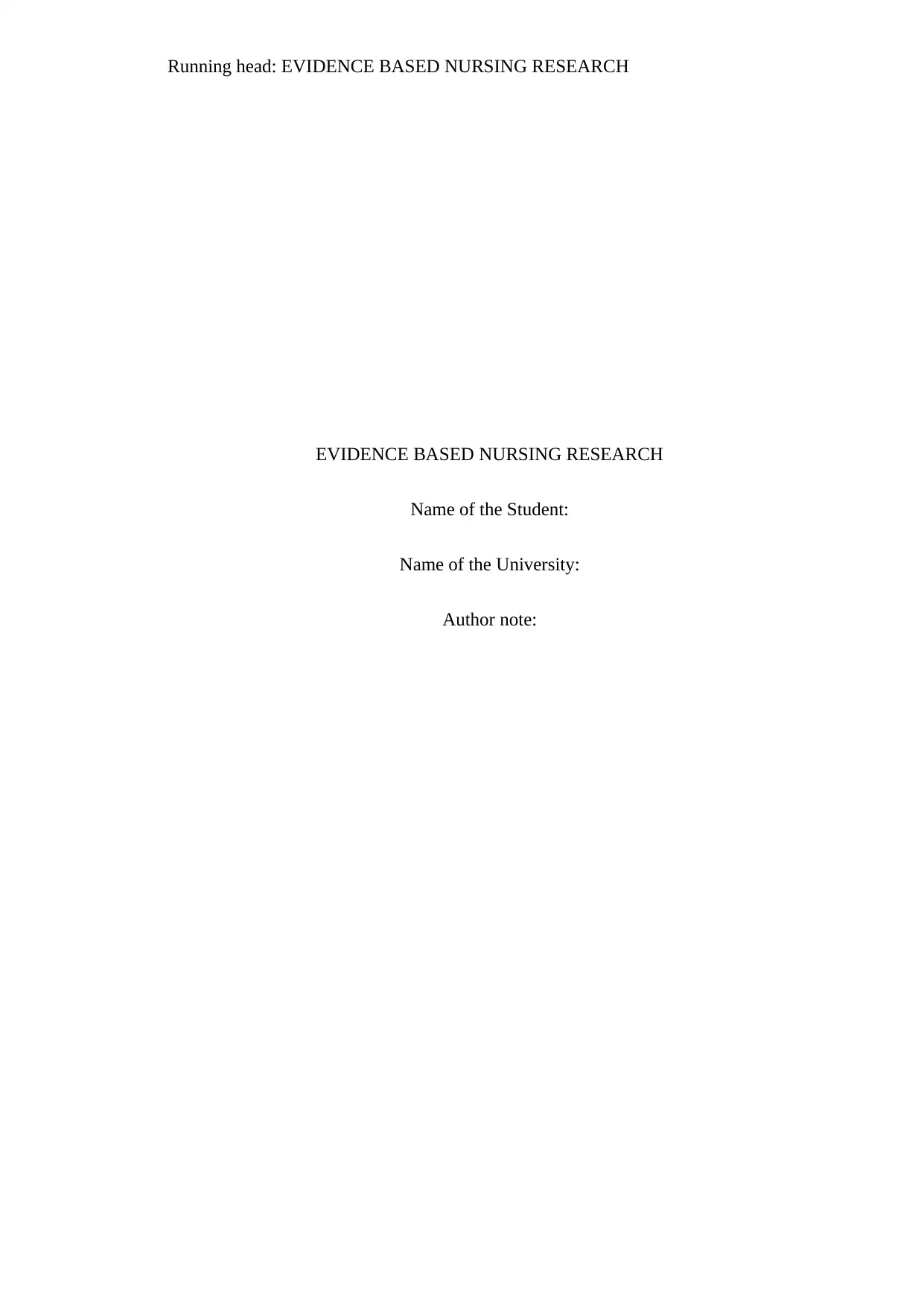
Running head: EVIDENCE BASED NURSING RESEARCH
EVIDENCE BASED NURSING RESEARCH
Name of the Student:
Name of the University:
Author note:
EVIDENCE BASED NURSING RESEARCH
Name of the Student:
Name of the University:
Author note:
Secure Best Marks with AI Grader
Need help grading? Try our AI Grader for instant feedback on your assignments.
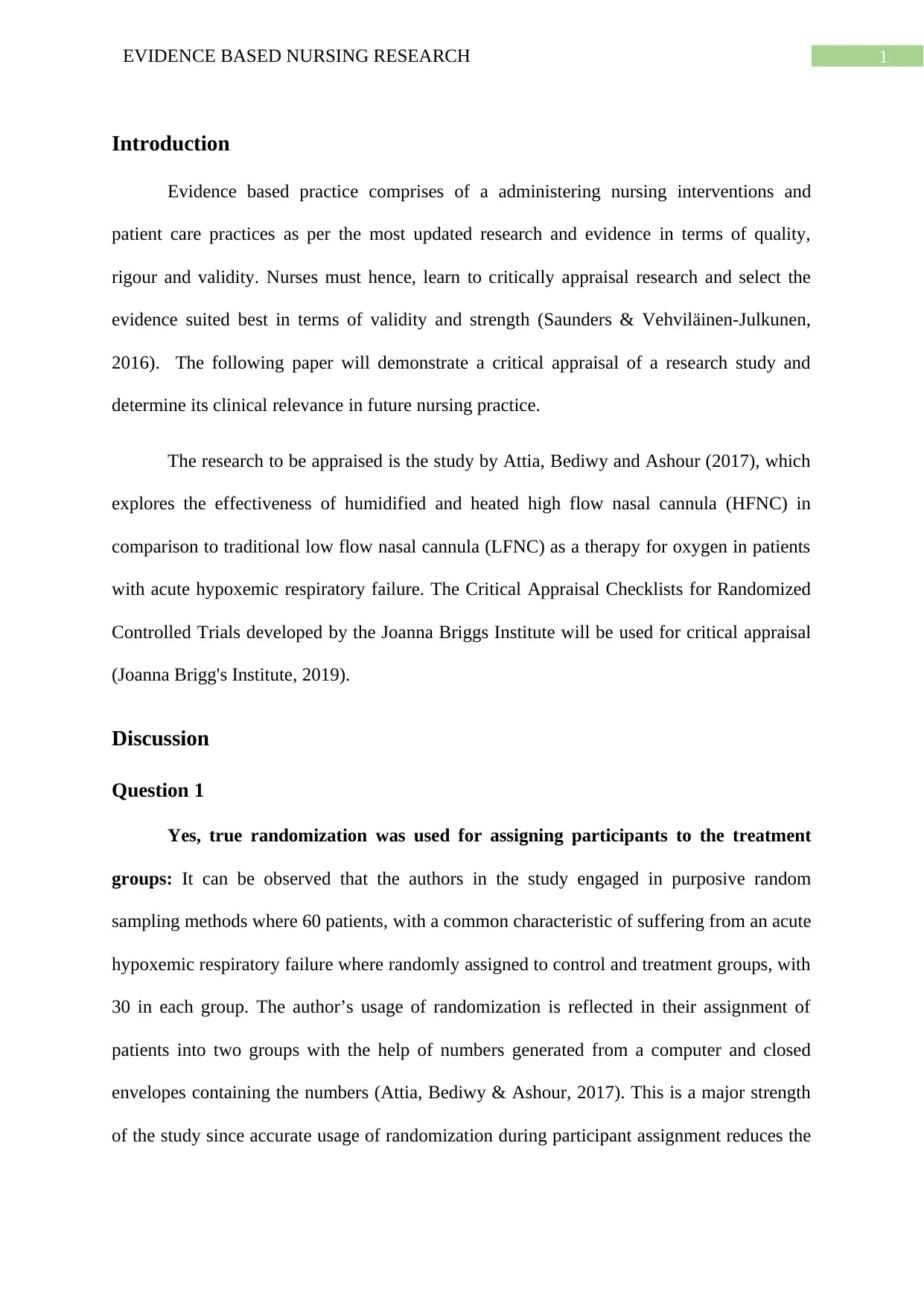
1EVIDENCE BASED NURSING RESEARCH
Introduction
Evidence based practice comprises of a administering nursing interventions and
patient care practices as per the most updated research and evidence in terms of quality,
rigour and validity. Nurses must hence, learn to critically appraisal research and select the
evidence suited best in terms of validity and strength (Saunders & Vehviläinen-Julkunen,
2016). The following paper will demonstrate a critical appraisal of a research study and
determine its clinical relevance in future nursing practice.
The research to be appraised is the study by Attia, Bediwy and Ashour (2017), which
explores the effectiveness of humidified and heated high flow nasal cannula (HFNC) in
comparison to traditional low flow nasal cannula (LFNC) as a therapy for oxygen in patients
with acute hypoxemic respiratory failure. The Critical Appraisal Checklists for Randomized
Controlled Trials developed by the Joanna Briggs Institute will be used for critical appraisal
(Joanna Brigg's Institute, 2019).
Discussion
Question 1
Yes, true randomization was used for assigning participants to the treatment
groups: It can be observed that the authors in the study engaged in purposive random
sampling methods where 60 patients, with a common characteristic of suffering from an acute
hypoxemic respiratory failure where randomly assigned to control and treatment groups, with
30 in each group. The author’s usage of randomization is reflected in their assignment of
patients into two groups with the help of numbers generated from a computer and closed
envelopes containing the numbers (Attia, Bediwy & Ashour, 2017). This is a major strength
of the study since accurate usage of randomization during participant assignment reduces the
Introduction
Evidence based practice comprises of a administering nursing interventions and
patient care practices as per the most updated research and evidence in terms of quality,
rigour and validity. Nurses must hence, learn to critically appraisal research and select the
evidence suited best in terms of validity and strength (Saunders & Vehviläinen-Julkunen,
2016). The following paper will demonstrate a critical appraisal of a research study and
determine its clinical relevance in future nursing practice.
The research to be appraised is the study by Attia, Bediwy and Ashour (2017), which
explores the effectiveness of humidified and heated high flow nasal cannula (HFNC) in
comparison to traditional low flow nasal cannula (LFNC) as a therapy for oxygen in patients
with acute hypoxemic respiratory failure. The Critical Appraisal Checklists for Randomized
Controlled Trials developed by the Joanna Briggs Institute will be used for critical appraisal
(Joanna Brigg's Institute, 2019).
Discussion
Question 1
Yes, true randomization was used for assigning participants to the treatment
groups: It can be observed that the authors in the study engaged in purposive random
sampling methods where 60 patients, with a common characteristic of suffering from an acute
hypoxemic respiratory failure where randomly assigned to control and treatment groups, with
30 in each group. The author’s usage of randomization is reflected in their assignment of
patients into two groups with the help of numbers generated from a computer and closed
envelopes containing the numbers (Attia, Bediwy & Ashour, 2017). This is a major strength
of the study since accurate usage of randomization during participant assignment reduces the
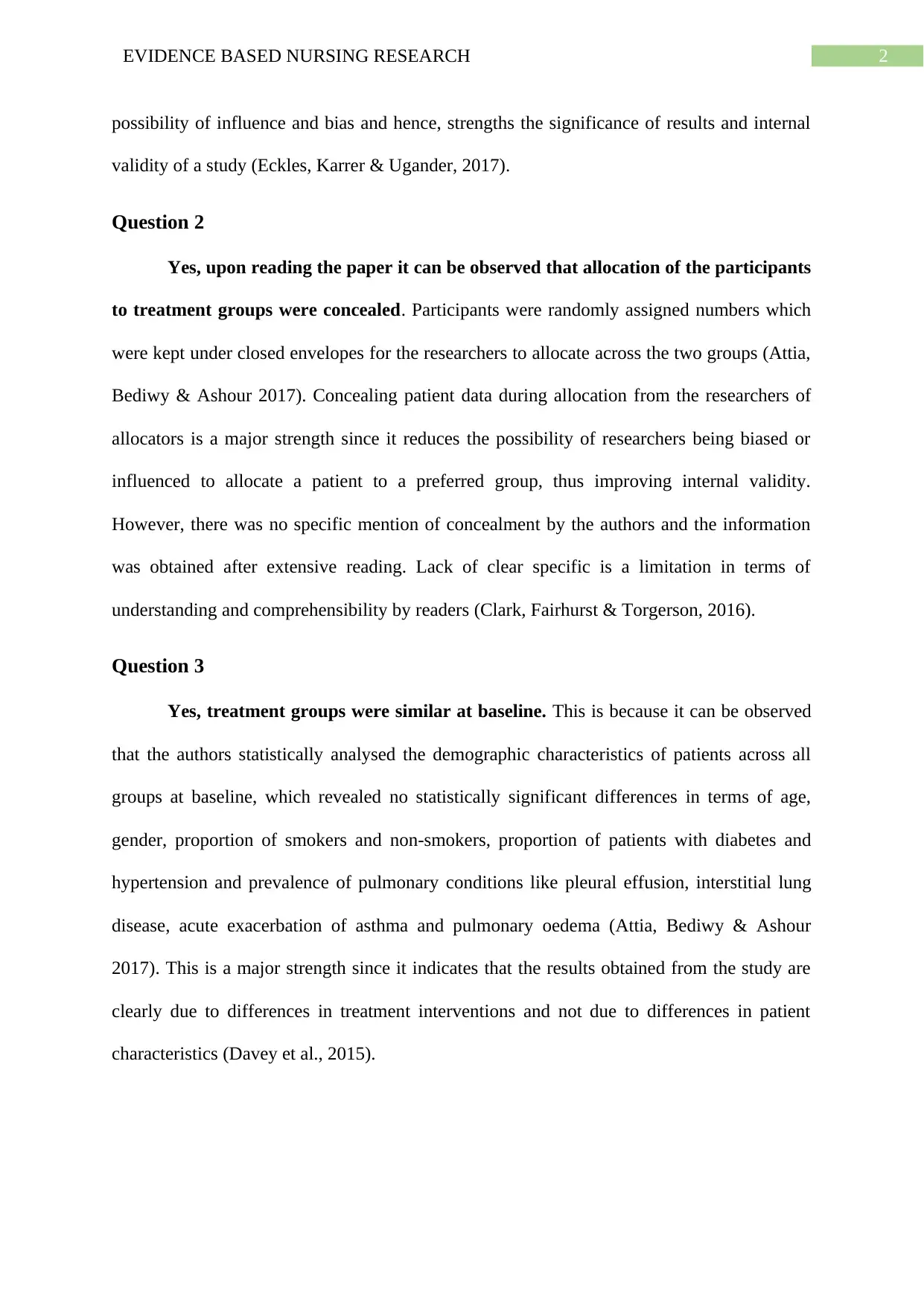
2EVIDENCE BASED NURSING RESEARCH
possibility of influence and bias and hence, strengths the significance of results and internal
validity of a study (Eckles, Karrer & Ugander, 2017).
Question 2
Yes, upon reading the paper it can be observed that allocation of the participants
to treatment groups were concealed. Participants were randomly assigned numbers which
were kept under closed envelopes for the researchers to allocate across the two groups (Attia,
Bediwy & Ashour 2017). Concealing patient data during allocation from the researchers of
allocators is a major strength since it reduces the possibility of researchers being biased or
influenced to allocate a patient to a preferred group, thus improving internal validity.
However, there was no specific mention of concealment by the authors and the information
was obtained after extensive reading. Lack of clear specific is a limitation in terms of
understanding and comprehensibility by readers (Clark, Fairhurst & Torgerson, 2016).
Question 3
Yes, treatment groups were similar at baseline. This is because it can be observed
that the authors statistically analysed the demographic characteristics of patients across all
groups at baseline, which revealed no statistically significant differences in terms of age,
gender, proportion of smokers and non-smokers, proportion of patients with diabetes and
hypertension and prevalence of pulmonary conditions like pleural effusion, interstitial lung
disease, acute exacerbation of asthma and pulmonary oedema (Attia, Bediwy & Ashour
2017). This is a major strength since it indicates that the results obtained from the study are
clearly due to differences in treatment interventions and not due to differences in patient
characteristics (Davey et al., 2015).
possibility of influence and bias and hence, strengths the significance of results and internal
validity of a study (Eckles, Karrer & Ugander, 2017).
Question 2
Yes, upon reading the paper it can be observed that allocation of the participants
to treatment groups were concealed. Participants were randomly assigned numbers which
were kept under closed envelopes for the researchers to allocate across the two groups (Attia,
Bediwy & Ashour 2017). Concealing patient data during allocation from the researchers of
allocators is a major strength since it reduces the possibility of researchers being biased or
influenced to allocate a patient to a preferred group, thus improving internal validity.
However, there was no specific mention of concealment by the authors and the information
was obtained after extensive reading. Lack of clear specific is a limitation in terms of
understanding and comprehensibility by readers (Clark, Fairhurst & Torgerson, 2016).
Question 3
Yes, treatment groups were similar at baseline. This is because it can be observed
that the authors statistically analysed the demographic characteristics of patients across all
groups at baseline, which revealed no statistically significant differences in terms of age,
gender, proportion of smokers and non-smokers, proportion of patients with diabetes and
hypertension and prevalence of pulmonary conditions like pleural effusion, interstitial lung
disease, acute exacerbation of asthma and pulmonary oedema (Attia, Bediwy & Ashour
2017). This is a major strength since it indicates that the results obtained from the study are
clearly due to differences in treatment interventions and not due to differences in patient
characteristics (Davey et al., 2015).
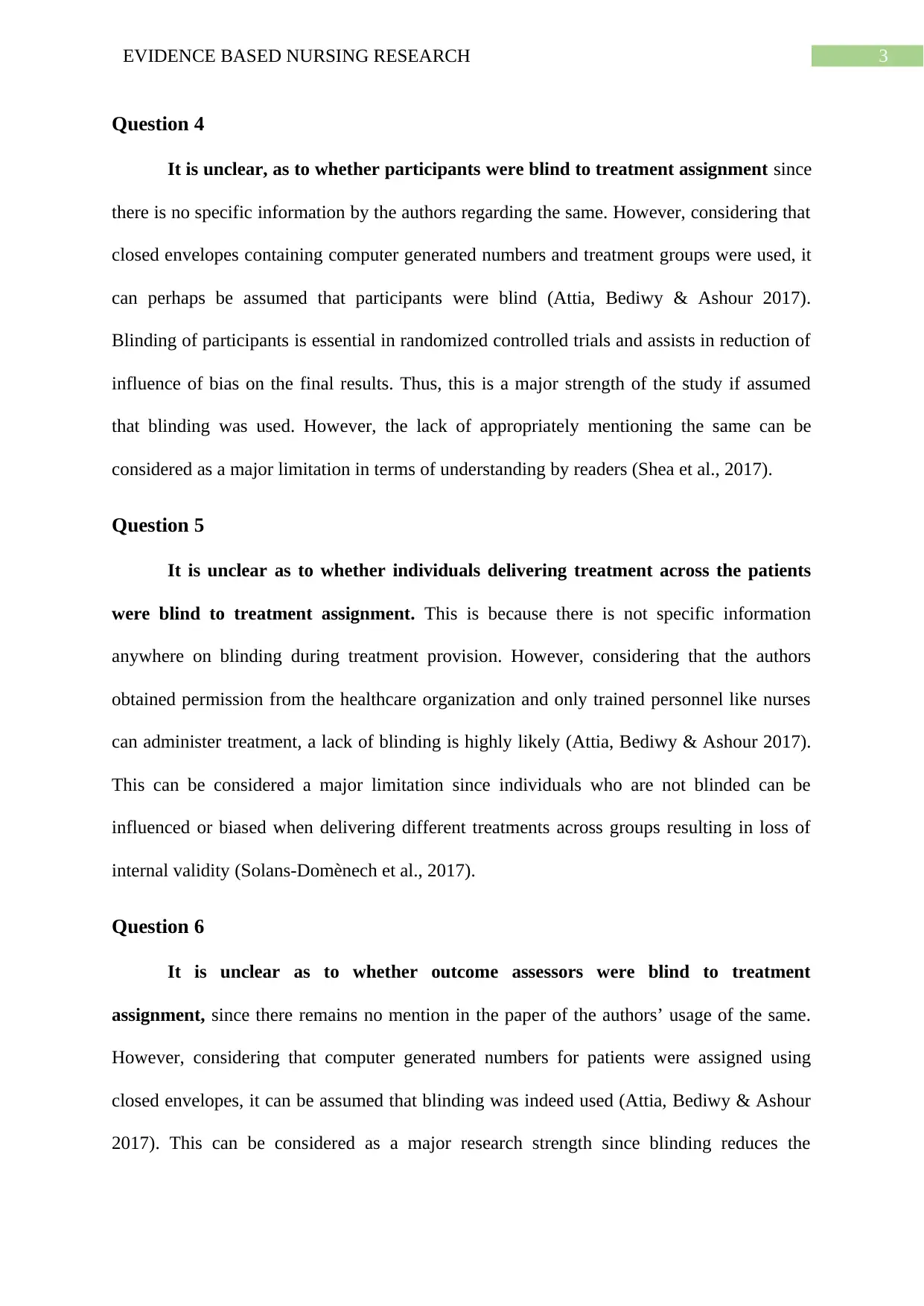
3EVIDENCE BASED NURSING RESEARCH
Question 4
It is unclear, as to whether participants were blind to treatment assignment since
there is no specific information by the authors regarding the same. However, considering that
closed envelopes containing computer generated numbers and treatment groups were used, it
can perhaps be assumed that participants were blind (Attia, Bediwy & Ashour 2017).
Blinding of participants is essential in randomized controlled trials and assists in reduction of
influence of bias on the final results. Thus, this is a major strength of the study if assumed
that blinding was used. However, the lack of appropriately mentioning the same can be
considered as a major limitation in terms of understanding by readers (Shea et al., 2017).
Question 5
It is unclear as to whether individuals delivering treatment across the patients
were blind to treatment assignment. This is because there is not specific information
anywhere on blinding during treatment provision. However, considering that the authors
obtained permission from the healthcare organization and only trained personnel like nurses
can administer treatment, a lack of blinding is highly likely (Attia, Bediwy & Ashour 2017).
This can be considered a major limitation since individuals who are not blinded can be
influenced or biased when delivering different treatments across groups resulting in loss of
internal validity (Solans-Domènech et al., 2017).
Question 6
It is unclear as to whether outcome assessors were blind to treatment
assignment, since there remains no mention in the paper of the authors’ usage of the same.
However, considering that computer generated numbers for patients were assigned using
closed envelopes, it can be assumed that blinding was indeed used (Attia, Bediwy & Ashour
2017). This can be considered as a major research strength since blinding reduces the
Question 4
It is unclear, as to whether participants were blind to treatment assignment since
there is no specific information by the authors regarding the same. However, considering that
closed envelopes containing computer generated numbers and treatment groups were used, it
can perhaps be assumed that participants were blind (Attia, Bediwy & Ashour 2017).
Blinding of participants is essential in randomized controlled trials and assists in reduction of
influence of bias on the final results. Thus, this is a major strength of the study if assumed
that blinding was used. However, the lack of appropriately mentioning the same can be
considered as a major limitation in terms of understanding by readers (Shea et al., 2017).
Question 5
It is unclear as to whether individuals delivering treatment across the patients
were blind to treatment assignment. This is because there is not specific information
anywhere on blinding during treatment provision. However, considering that the authors
obtained permission from the healthcare organization and only trained personnel like nurses
can administer treatment, a lack of blinding is highly likely (Attia, Bediwy & Ashour 2017).
This can be considered a major limitation since individuals who are not blinded can be
influenced or biased when delivering different treatments across groups resulting in loss of
internal validity (Solans-Domènech et al., 2017).
Question 6
It is unclear as to whether outcome assessors were blind to treatment
assignment, since there remains no mention in the paper of the authors’ usage of the same.
However, considering that computer generated numbers for patients were assigned using
closed envelopes, it can be assumed that blinding was indeed used (Attia, Bediwy & Ashour
2017). This can be considered as a major research strength since blinding reduces the
Secure Best Marks with AI Grader
Need help grading? Try our AI Grader for instant feedback on your assignments.
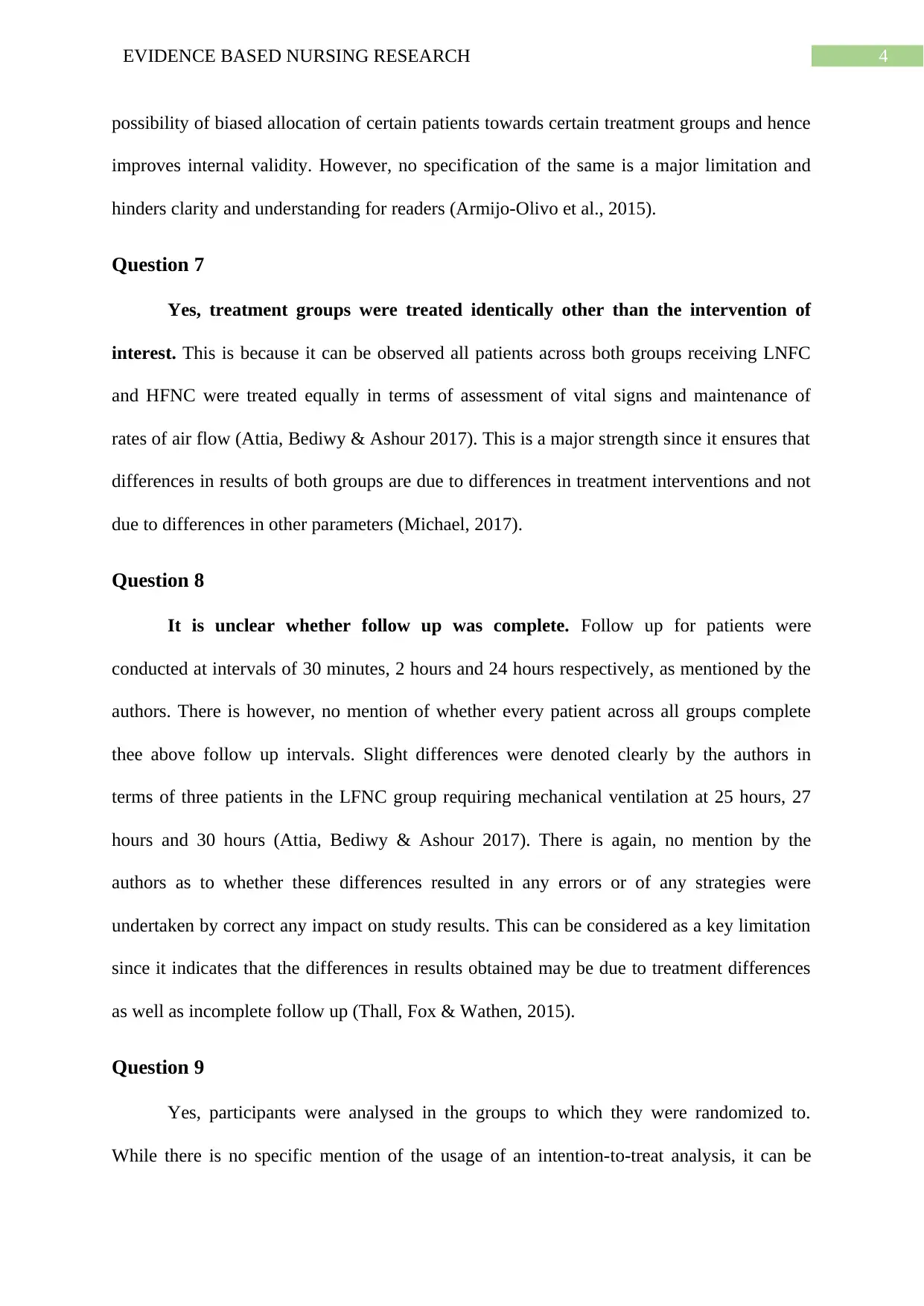
4EVIDENCE BASED NURSING RESEARCH
possibility of biased allocation of certain patients towards certain treatment groups and hence
improves internal validity. However, no specification of the same is a major limitation and
hinders clarity and understanding for readers (Armijo-Olivo et al., 2015).
Question 7
Yes, treatment groups were treated identically other than the intervention of
interest. This is because it can be observed all patients across both groups receiving LNFC
and HFNC were treated equally in terms of assessment of vital signs and maintenance of
rates of air flow (Attia, Bediwy & Ashour 2017). This is a major strength since it ensures that
differences in results of both groups are due to differences in treatment interventions and not
due to differences in other parameters (Michael, 2017).
Question 8
It is unclear whether follow up was complete. Follow up for patients were
conducted at intervals of 30 minutes, 2 hours and 24 hours respectively, as mentioned by the
authors. There is however, no mention of whether every patient across all groups complete
thee above follow up intervals. Slight differences were denoted clearly by the authors in
terms of three patients in the LFNC group requiring mechanical ventilation at 25 hours, 27
hours and 30 hours (Attia, Bediwy & Ashour 2017). There is again, no mention by the
authors as to whether these differences resulted in any errors or of any strategies were
undertaken by correct any impact on study results. This can be considered as a key limitation
since it indicates that the differences in results obtained may be due to treatment differences
as well as incomplete follow up (Thall, Fox & Wathen, 2015).
Question 9
Yes, participants were analysed in the groups to which they were randomized to.
While there is no specific mention of the usage of an intention-to-treat analysis, it can be
possibility of biased allocation of certain patients towards certain treatment groups and hence
improves internal validity. However, no specification of the same is a major limitation and
hinders clarity and understanding for readers (Armijo-Olivo et al., 2015).
Question 7
Yes, treatment groups were treated identically other than the intervention of
interest. This is because it can be observed all patients across both groups receiving LNFC
and HFNC were treated equally in terms of assessment of vital signs and maintenance of
rates of air flow (Attia, Bediwy & Ashour 2017). This is a major strength since it ensures that
differences in results of both groups are due to differences in treatment interventions and not
due to differences in other parameters (Michael, 2017).
Question 8
It is unclear whether follow up was complete. Follow up for patients were
conducted at intervals of 30 minutes, 2 hours and 24 hours respectively, as mentioned by the
authors. There is however, no mention of whether every patient across all groups complete
thee above follow up intervals. Slight differences were denoted clearly by the authors in
terms of three patients in the LFNC group requiring mechanical ventilation at 25 hours, 27
hours and 30 hours (Attia, Bediwy & Ashour 2017). There is again, no mention by the
authors as to whether these differences resulted in any errors or of any strategies were
undertaken by correct any impact on study results. This can be considered as a key limitation
since it indicates that the differences in results obtained may be due to treatment differences
as well as incomplete follow up (Thall, Fox & Wathen, 2015).
Question 9
Yes, participants were analysed in the groups to which they were randomized to.
While there is no specific mention of the usage of an intention-to-treat analysis, it can be
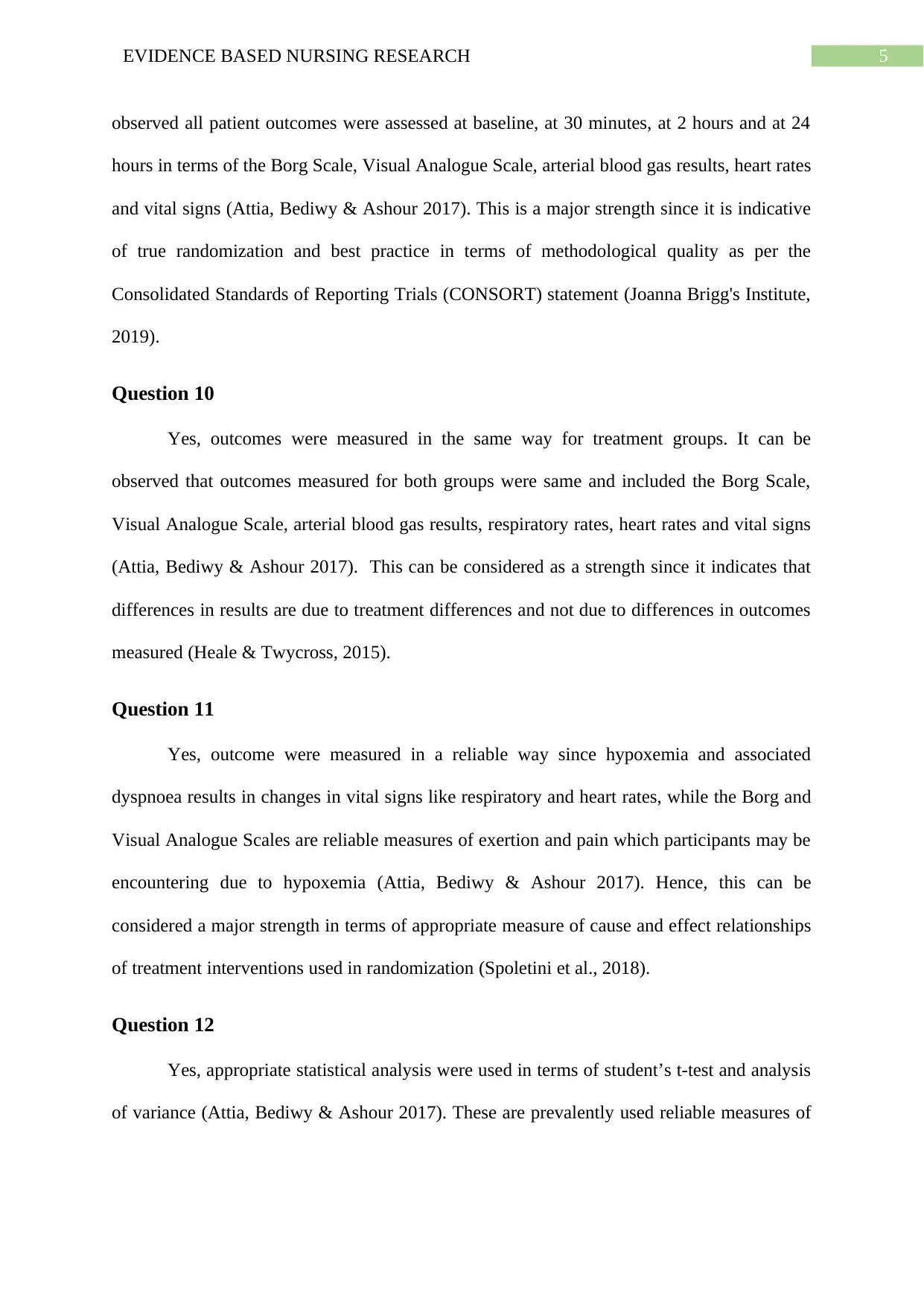
5EVIDENCE BASED NURSING RESEARCH
observed all patient outcomes were assessed at baseline, at 30 minutes, at 2 hours and at 24
hours in terms of the Borg Scale, Visual Analogue Scale, arterial blood gas results, heart rates
and vital signs (Attia, Bediwy & Ashour 2017). This is a major strength since it is indicative
of true randomization and best practice in terms of methodological quality as per the
Consolidated Standards of Reporting Trials (CONSORT) statement (Joanna Brigg's Institute,
2019).
Question 10
Yes, outcomes were measured in the same way for treatment groups. It can be
observed that outcomes measured for both groups were same and included the Borg Scale,
Visual Analogue Scale, arterial blood gas results, respiratory rates, heart rates and vital signs
(Attia, Bediwy & Ashour 2017). This can be considered as a strength since it indicates that
differences in results are due to treatment differences and not due to differences in outcomes
measured (Heale & Twycross, 2015).
Question 11
Yes, outcome were measured in a reliable way since hypoxemia and associated
dyspnoea results in changes in vital signs like respiratory and heart rates, while the Borg and
Visual Analogue Scales are reliable measures of exertion and pain which participants may be
encountering due to hypoxemia (Attia, Bediwy & Ashour 2017). Hence, this can be
considered a major strength in terms of appropriate measure of cause and effect relationships
of treatment interventions used in randomization (Spoletini et al., 2018).
Question 12
Yes, appropriate statistical analysis were used in terms of student’s t-test and analysis
of variance (Attia, Bediwy & Ashour 2017). These are prevalently used reliable measures of
observed all patient outcomes were assessed at baseline, at 30 minutes, at 2 hours and at 24
hours in terms of the Borg Scale, Visual Analogue Scale, arterial blood gas results, heart rates
and vital signs (Attia, Bediwy & Ashour 2017). This is a major strength since it is indicative
of true randomization and best practice in terms of methodological quality as per the
Consolidated Standards of Reporting Trials (CONSORT) statement (Joanna Brigg's Institute,
2019).
Question 10
Yes, outcomes were measured in the same way for treatment groups. It can be
observed that outcomes measured for both groups were same and included the Borg Scale,
Visual Analogue Scale, arterial blood gas results, respiratory rates, heart rates and vital signs
(Attia, Bediwy & Ashour 2017). This can be considered as a strength since it indicates that
differences in results are due to treatment differences and not due to differences in outcomes
measured (Heale & Twycross, 2015).
Question 11
Yes, outcome were measured in a reliable way since hypoxemia and associated
dyspnoea results in changes in vital signs like respiratory and heart rates, while the Borg and
Visual Analogue Scales are reliable measures of exertion and pain which participants may be
encountering due to hypoxemia (Attia, Bediwy & Ashour 2017). Hence, this can be
considered a major strength in terms of appropriate measure of cause and effect relationships
of treatment interventions used in randomization (Spoletini et al., 2018).
Question 12
Yes, appropriate statistical analysis were used in terms of student’s t-test and analysis
of variance (Attia, Bediwy & Ashour 2017). These are prevalently used reliable measures of
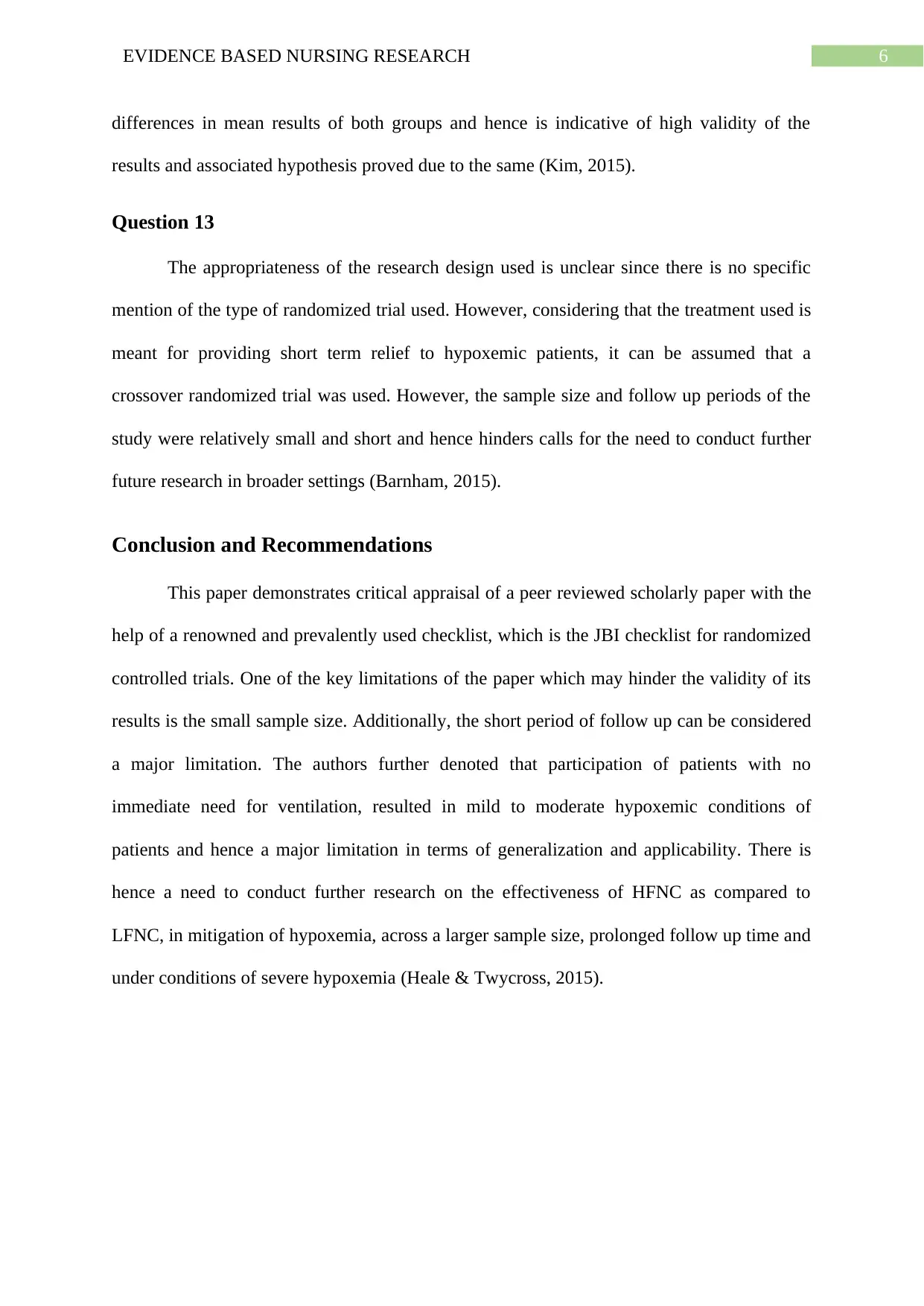
6EVIDENCE BASED NURSING RESEARCH
differences in mean results of both groups and hence is indicative of high validity of the
results and associated hypothesis proved due to the same (Kim, 2015).
Question 13
The appropriateness of the research design used is unclear since there is no specific
mention of the type of randomized trial used. However, considering that the treatment used is
meant for providing short term relief to hypoxemic patients, it can be assumed that a
crossover randomized trial was used. However, the sample size and follow up periods of the
study were relatively small and short and hence hinders calls for the need to conduct further
future research in broader settings (Barnham, 2015).
Conclusion and Recommendations
This paper demonstrates critical appraisal of a peer reviewed scholarly paper with the
help of a renowned and prevalently used checklist, which is the JBI checklist for randomized
controlled trials. One of the key limitations of the paper which may hinder the validity of its
results is the small sample size. Additionally, the short period of follow up can be considered
a major limitation. The authors further denoted that participation of patients with no
immediate need for ventilation, resulted in mild to moderate hypoxemic conditions of
patients and hence a major limitation in terms of generalization and applicability. There is
hence a need to conduct further research on the effectiveness of HFNC as compared to
LFNC, in mitigation of hypoxemia, across a larger sample size, prolonged follow up time and
under conditions of severe hypoxemia (Heale & Twycross, 2015).
differences in mean results of both groups and hence is indicative of high validity of the
results and associated hypothesis proved due to the same (Kim, 2015).
Question 13
The appropriateness of the research design used is unclear since there is no specific
mention of the type of randomized trial used. However, considering that the treatment used is
meant for providing short term relief to hypoxemic patients, it can be assumed that a
crossover randomized trial was used. However, the sample size and follow up periods of the
study were relatively small and short and hence hinders calls for the need to conduct further
future research in broader settings (Barnham, 2015).
Conclusion and Recommendations
This paper demonstrates critical appraisal of a peer reviewed scholarly paper with the
help of a renowned and prevalently used checklist, which is the JBI checklist for randomized
controlled trials. One of the key limitations of the paper which may hinder the validity of its
results is the small sample size. Additionally, the short period of follow up can be considered
a major limitation. The authors further denoted that participation of patients with no
immediate need for ventilation, resulted in mild to moderate hypoxemic conditions of
patients and hence a major limitation in terms of generalization and applicability. There is
hence a need to conduct further research on the effectiveness of HFNC as compared to
LFNC, in mitigation of hypoxemia, across a larger sample size, prolonged follow up time and
under conditions of severe hypoxemia (Heale & Twycross, 2015).
Paraphrase This Document
Need a fresh take? Get an instant paraphrase of this document with our AI Paraphraser
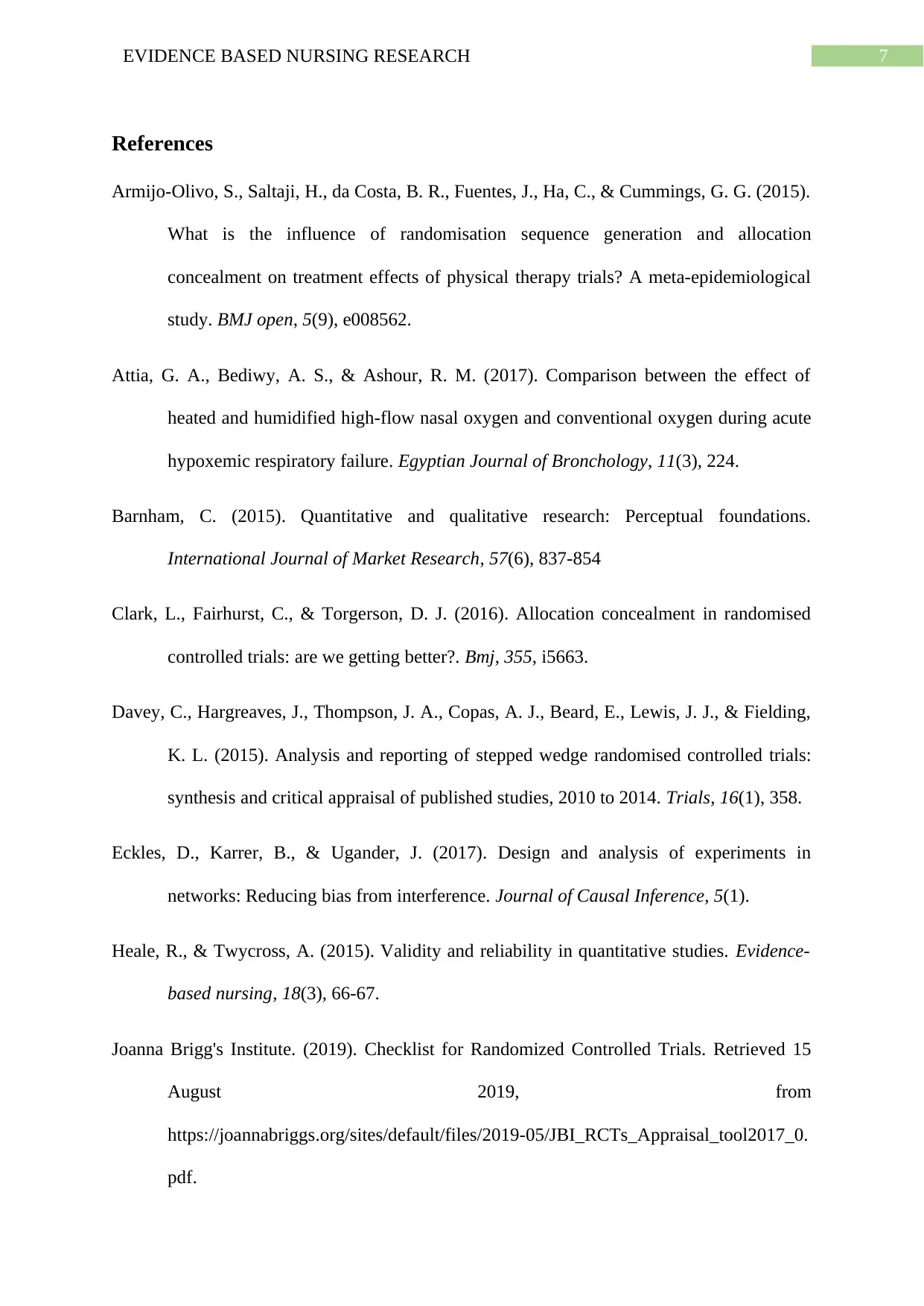
7EVIDENCE BASED NURSING RESEARCH
References
Armijo-Olivo, S., Saltaji, H., da Costa, B. R., Fuentes, J., Ha, C., & Cummings, G. G. (2015).
What is the influence of randomisation sequence generation and allocation
concealment on treatment effects of physical therapy trials? A meta-epidemiological
study. BMJ open, 5(9), e008562.
Attia, G. A., Bediwy, A. S., & Ashour, R. M. (2017). Comparison between the effect of
heated and humidified high-flow nasal oxygen and conventional oxygen during acute
hypoxemic respiratory failure. Egyptian Journal of Bronchology, 11(3), 224.
Barnham, C. (2015). Quantitative and qualitative research: Perceptual foundations.
International Journal of Market Research, 57(6), 837-854
Clark, L., Fairhurst, C., & Torgerson, D. J. (2016). Allocation concealment in randomised
controlled trials: are we getting better?. Bmj, 355, i5663.
Davey, C., Hargreaves, J., Thompson, J. A., Copas, A. J., Beard, E., Lewis, J. J., & Fielding,
K. L. (2015). Analysis and reporting of stepped wedge randomised controlled trials:
synthesis and critical appraisal of published studies, 2010 to 2014. Trials, 16(1), 358.
Eckles, D., Karrer, B., & Ugander, J. (2017). Design and analysis of experiments in
networks: Reducing bias from interference. Journal of Causal Inference, 5(1).
Heale, R., & Twycross, A. (2015). Validity and reliability in quantitative studies. Evidence-
based nursing, 18(3), 66-67.
Joanna Brigg's Institute. (2019). Checklist for Randomized Controlled Trials. Retrieved 15
August 2019, from
https://joannabriggs.org/sites/default/files/2019-05/JBI_RCTs_Appraisal_tool2017_0.
pdf.
References
Armijo-Olivo, S., Saltaji, H., da Costa, B. R., Fuentes, J., Ha, C., & Cummings, G. G. (2015).
What is the influence of randomisation sequence generation and allocation
concealment on treatment effects of physical therapy trials? A meta-epidemiological
study. BMJ open, 5(9), e008562.
Attia, G. A., Bediwy, A. S., & Ashour, R. M. (2017). Comparison between the effect of
heated and humidified high-flow nasal oxygen and conventional oxygen during acute
hypoxemic respiratory failure. Egyptian Journal of Bronchology, 11(3), 224.
Barnham, C. (2015). Quantitative and qualitative research: Perceptual foundations.
International Journal of Market Research, 57(6), 837-854
Clark, L., Fairhurst, C., & Torgerson, D. J. (2016). Allocation concealment in randomised
controlled trials: are we getting better?. Bmj, 355, i5663.
Davey, C., Hargreaves, J., Thompson, J. A., Copas, A. J., Beard, E., Lewis, J. J., & Fielding,
K. L. (2015). Analysis and reporting of stepped wedge randomised controlled trials:
synthesis and critical appraisal of published studies, 2010 to 2014. Trials, 16(1), 358.
Eckles, D., Karrer, B., & Ugander, J. (2017). Design and analysis of experiments in
networks: Reducing bias from interference. Journal of Causal Inference, 5(1).
Heale, R., & Twycross, A. (2015). Validity and reliability in quantitative studies. Evidence-
based nursing, 18(3), 66-67.
Joanna Brigg's Institute. (2019). Checklist for Randomized Controlled Trials. Retrieved 15
August 2019, from
https://joannabriggs.org/sites/default/files/2019-05/JBI_RCTs_Appraisal_tool2017_0.
pdf.
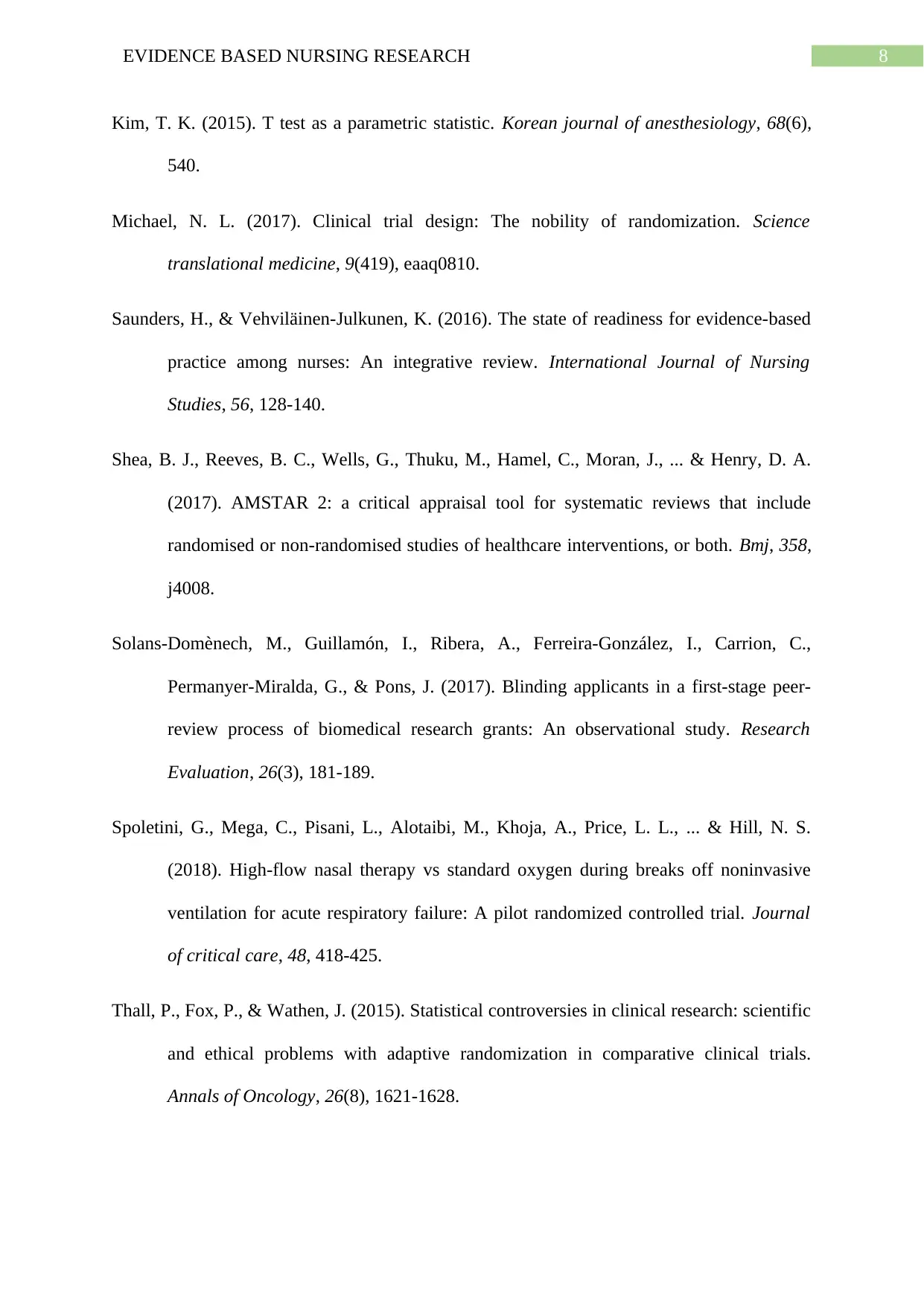
8EVIDENCE BASED NURSING RESEARCH
Kim, T. K. (2015). T test as a parametric statistic. Korean journal of anesthesiology, 68(6),
540.
Michael, N. L. (2017). Clinical trial design: The nobility of randomization. Science
translational medicine, 9(419), eaaq0810.
Saunders, H., & Vehviläinen-Julkunen, K. (2016). The state of readiness for evidence-based
practice among nurses: An integrative review. International Journal of Nursing
Studies, 56, 128-140.
Shea, B. J., Reeves, B. C., Wells, G., Thuku, M., Hamel, C., Moran, J., ... & Henry, D. A.
(2017). AMSTAR 2: a critical appraisal tool for systematic reviews that include
randomised or non-randomised studies of healthcare interventions, or both. Bmj, 358,
j4008.
Solans-Domènech, M., Guillamón, I., Ribera, A., Ferreira-González, I., Carrion, C.,
Permanyer-Miralda, G., & Pons, J. (2017). Blinding applicants in a first-stage peer-
review process of biomedical research grants: An observational study. Research
Evaluation, 26(3), 181-189.
Spoletini, G., Mega, C., Pisani, L., Alotaibi, M., Khoja, A., Price, L. L., ... & Hill, N. S.
(2018). High-flow nasal therapy vs standard oxygen during breaks off noninvasive
ventilation for acute respiratory failure: A pilot randomized controlled trial. Journal
of critical care, 48, 418-425.
Thall, P., Fox, P., & Wathen, J. (2015). Statistical controversies in clinical research: scientific
and ethical problems with adaptive randomization in comparative clinical trials.
Annals of Oncology, 26(8), 1621-1628.
Kim, T. K. (2015). T test as a parametric statistic. Korean journal of anesthesiology, 68(6),
540.
Michael, N. L. (2017). Clinical trial design: The nobility of randomization. Science
translational medicine, 9(419), eaaq0810.
Saunders, H., & Vehviläinen-Julkunen, K. (2016). The state of readiness for evidence-based
practice among nurses: An integrative review. International Journal of Nursing
Studies, 56, 128-140.
Shea, B. J., Reeves, B. C., Wells, G., Thuku, M., Hamel, C., Moran, J., ... & Henry, D. A.
(2017). AMSTAR 2: a critical appraisal tool for systematic reviews that include
randomised or non-randomised studies of healthcare interventions, or both. Bmj, 358,
j4008.
Solans-Domènech, M., Guillamón, I., Ribera, A., Ferreira-González, I., Carrion, C.,
Permanyer-Miralda, G., & Pons, J. (2017). Blinding applicants in a first-stage peer-
review process of biomedical research grants: An observational study. Research
Evaluation, 26(3), 181-189.
Spoletini, G., Mega, C., Pisani, L., Alotaibi, M., Khoja, A., Price, L. L., ... & Hill, N. S.
(2018). High-flow nasal therapy vs standard oxygen during breaks off noninvasive
ventilation for acute respiratory failure: A pilot randomized controlled trial. Journal
of critical care, 48, 418-425.
Thall, P., Fox, P., & Wathen, J. (2015). Statistical controversies in clinical research: scientific
and ethical problems with adaptive randomization in comparative clinical trials.
Annals of Oncology, 26(8), 1621-1628.
1 out of 9
Related Documents
Your All-in-One AI-Powered Toolkit for Academic Success.
+13062052269
info@desklib.com
Available 24*7 on WhatsApp / Email
![[object Object]](/_next/static/media/star-bottom.7253800d.svg)
Unlock your academic potential
© 2024 | Zucol Services PVT LTD | All rights reserved.





